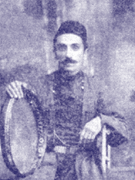Dr. Peyman Nasehpour

Dzhabbar Kariagdiev
Ghaval (not to be confused with qawwali music) the Azerbaijani frame drum is played in Azerbaijani folk and art music. In folk music of Azerbaijan Ashigh (poet-musician) sings and plays on gopuz (nine-stringed long-necked lute) and sometimes composes poems in different festive occasions. The drum that usually accompanies the Ashigh is ghaval. In Azerbaijani art music a traditional ensemble contains a singer, which plays on ghaval and two instrumentalists, one plays on tar (long-necked lute) and the other plays on kamancheh (bowed spike fiddle). In modern art music of Azerbaijan an ensemble can contain more than two instrumentalists. Usually the drum that accompanies the modern ensemble is naghara (a kind of cylindrical drum that is called in Armenia dhol).
Ghaval is the same as Persian dayereh. In Persia (Iran) there are different types of frame drum. But only daf is considered as the only national frame drum. It is unfortunate that ghaval is not integrated into Persian art music like the daf, though some ghaval players particularly the late Mahmoud Farnam tried to do this by accompanying the great masters of Persian art music, Ostad Eghbal Azar (very skillful vocalist) and Ostad Gholam Hossein Bigchekhani (very skillful tar player).
The history of dayereh goes back to many centuries. An engraved bronze cup from Lorestan at the Notional Museum of Iran, Tehran, portrays a double ney (reed pipes), chang (harp), and dayereh in a shrine or court processional, as similarly documented in Egypt, Elam, and Babylonia where music involved the utilization of large orchestral ensembles.
Some believe that the word dayereh comes from the Pahlavi (Persian pre-Islamic language) name dareh. Abu Saeed Abolkheir (967-1048), the poet, has mentioned in his works to the word dayereh as a drum.
Ghaval was not considered a solo instrument. After the effort of Ostad Latif Tahmasebi-zadeh ghaval has found an independent role.
Ghaval's frame is wooden and the skin stretched on it can be goatskin or fish skin, though today the head of modern ghavals is synthetic (plastic) because the skin-headed ghaval is sensitive to changes in humidity. Some metal rings are incorporated into the drum to provide jingle. Its is much larger than Western tambourine but smaller than daf.
Basic Rhythms of Ghaval
There are four basic rhythms in Azerbaijani art music.
Diringi: Diringi is a light rhythm for dance music, though it is found in vocal music also. It is played in both low and high tempo, depending on the occasion of the performance. Diringi can be considered the same as Persian Reng.
Yalli: Yalli is another light rhythm for different rhythmic compositions of vocal and instrumental music.
Lazgi: Lazgi is the most famous Azerbaijani dance. It is played in medium to high tempo. It is for instrumental music.
Mahni: Mahni is in fact the rhythmic form for vocal music. The most famous rhythm for Mahni has been linked here. Mahni can be considered the same as Persian Tasnif.
Please note that I have played the rhythm in slow tempo for instructional purposes.
Glossary
Ashigh: (Pl. Ashighlar) Some believe that Ashigh comes from the Arabic word eshgh (love). While the others believe that Ashigh comes from Ashk and Ashkanian. They reach the history of Ashigh to the Ashkanian period (Parthian period 247 B.C.-224 A.D.) and they mention to this point that Ashghabad (capital of today Republic of Turkmenistan) had been one of the most important centers of Ashkanian. A famous tradition in the art of Ashighlar is really wonderful. This tradition that is called de'ishma is a kind of musical debate. According to a very old tradition of the skillful Ashigh-s, occasionally the Ashigh-s do this musical debate (de'ishma) and every Ashigh that loses should give his instrument (the saz or the gopuz) to the winner and leave his job. In this musical debate to compose poems by improvisation is often the winning trump.
Gopuz: Gopuz is the long-necked lute to be played by the Ashigh in Azerbaijan. It is called Saz too and Saz is generic name for musical instrument in Iran, Turkey and India. There is a similar instrument to gopuz in Turkey that is called Baglama.
Kamancheh: Kamancheh is bowed spike fiddle to be played in Iran, Azerbaijan, Armenia, Central Asia, Turkey and Egypt. Kaman literally means bow. Many musicologists consider the kamancheh the predecessor of the violin.
Qawwali: Qawwali or ghawwali or kawali is the Islamic devotional song. It is a lively, light style, which has a popular appeal for both Muslims and Hindus alike.
Tar: Tar is a long-necked lute to be played in Iran. Its Persian version sometimes is called tar-e-shiraz (tar of Shiraz which is one of the most important cities of Persia and located in SW) and its Azerbaijani version is called tar-e-ghafghaz (tar of Caucasus). Tar literally means string, chord and so on. The word tar can be see in some other musical instruments such as ektar, dotar, setar, sitar, khoshtar and guitar. Not to be confused with Egyptian tar witch is a kind of frame drum.
References:
[N]: Peyman
Nasehpour, Personal Interview with Ostad Latif
Tahmasebi-zadeh, Aug. 1994-Aug. 1995.
[S]: Mehdi Setayeshgar, Vazhe-Name-ye-Musighi-ye-Iran Zamin, Tehran, Vol. I (1995) & Vol. II (1996).